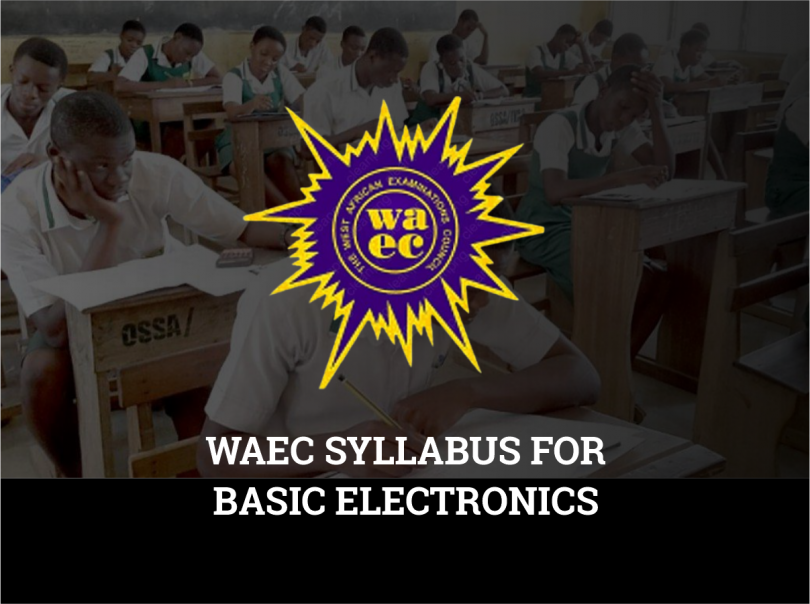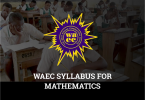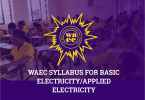The WAEC Basic Electronics syllabus for 2025 is an essential guide/roadmap for students who are preparing for the WAEC exams. The WAEC Syllabus for Basic Electronics is now available online, and if you are writing the exams, you need to understand the syllabus to ensure your success in the examination. The syllabus outlines the key topics and practical skills required, ensuring that candidates focus their studies effectively and are well-prepared for both theoretical and practical assessments.
In this article, we will show you everything you need to know and understand about the WAEC Syllabus for Basic Electronics. As a candidate, ensure you go through this article carefully to learn the exam structure and study the syllabus effectively to succeed in your exams. Read carefully as we guide you!
Examination Structure
The examination comprises three papers:
- Paper 1: A 1-hour multiple-choice test with 50 questions, totaling 50 marks.
- Paper 2: A 1-hour theory paper with seven short-structured questions; candidates must answer any five, totaling 50 marks.
- Paper 3: A 3-hour practical examination involving two experiments, totaling 100 marks.
In cases where practical materials are unavailable, an alternative theoretical test will be conducted, consisting of two compulsory questions to be answered within 2 hours for 100 marks.
WAEC Syllabus For Basic Electronics – Overview
The syllabus is divided into several sections, each focusing on fundamental concepts and practical applications in electronics:
- Electron Emission: Study of types of electron emission and their applications.
- Measuring Instruments: Understanding the concepts, principles, and protection of measuring instruments.
- Semiconductors: Exploration of semiconductor materials (e.g., silicon, germanium), doping processes, and the formation of p-type and n-type semiconductors.
- Semiconductor Diodes: Concepts of diodes and their biasing techniques.
- Transistors: Study of transistor concepts and their applications.
- Other Semiconductor Devices: Examination of devices such as thermistors, diacs, triacs, and thyristors.
- Integrated Circuits: Understanding circuit symbols, principles of operation, and applications of integrated circuits.
- Circuit Analysis: Application of integrated circuits and explanations of memory types like RAM, ROM, and EPROM.
- Electric Current: Study of atomic structure, conductors, insulators, and sources of direct and alternating currents.
- Voltage, Current, and Resistance: Understanding the relationship between voltage, current, and resistance, including Ohm’s Law and related calculations.
- Electric Power: Concepts of electric power and its calculations.
- Circuit Components: Identification and understanding of resistors, capacitors, and inductors, including their symbols, units of measurement, and color coding.
- Electric Circuits: Study of electric circuits, including series, parallel, and series-parallel arrangements, and related calculations.
- Alternating Current Circuits: Understanding R-L-C circuits and generator principles.
- Power in A.C. Circuits: Qualitative and quantitative treatments of power, power factor, and related calculations.
- Amplifiers: Study of voltage and power amplifiers, including push-pull amplifiers and operational amplifiers.
- Power Supply: Understanding D.C. power supply units, rectification, and related components.
- Oscillators, Multivibrators, and Digital Basics: Study of oscillators, multivibrators, and basic digital concepts.
- Communication Systems, Transducers, and Sensors: Understanding electromagnetic waves, radio wave characteristics, and the principles of radio receivers, transmitters, and communication methods.
- Control Systems: Study of servo mechanisms and their applications.
- Magnetic and Electric Fields, Electromagnetic Induction/Transformers: Understanding electromagnetic fields, induction, and transformer principles.
Tips
The tips provided below will aid in excelling in the WAEC Basic Electronics examination:
- Familiarize yourself with all topics outlined in the syllabus.
- Refer to recommended textbooks and online materials for comprehensive learning.
- Solve previous years’ WAEC questions to get accustomed to the exam format and question styles.
- Stay updated on any changes or updates to the syllabus and examination patterns.
Conclusion
The WAEC syllabus for Basic Electronics 2025 provides a structured framework for students to prepare effectively for the examination. By aligning your studies with the syllabus, utilizing reliable resources, and engaging in practical exercises, you can enhance your understanding and performance in the subject. We hope you found this article helpful. Bookmark this page to stay updated and share this article with your family and friends to help interested ones excel in the exam.







Leave a Comment